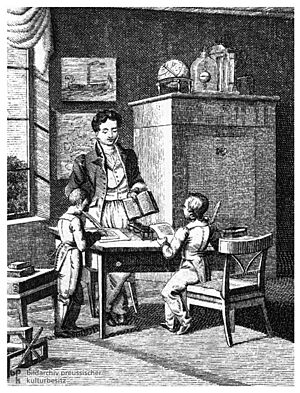Bourgeois revolution facts for kids
A bourgeois revolution is a big change in society, often a revolution, that aims to get rid of old systems like feudalism. It helps a new group, called the bourgeoisie (which means the middle and upper classes, like business owners), take power. This leads to the creation of a capitalist state, where businesses and trade are very important.
In countries that were controlled by others, these revolutions often became wars for independence. Famous examples include the Dutch, English, American, and French revolutions. They all tried to remove old medieval ways to make room for capitalism. This term is often compared to a "proletarian revolution", which is a revolution led by working-class people. Sometimes, it's also called a "bourgeois-democratic revolution".
Contents
What Are Bourgeois Revolutions About?
In Marxist thinking, a bourgeois revolution has several key goals:
- Creating a nation: This means forming a country with its own identity and government.
- Rule by the people: The government should be based on what the people want, often through a constitution (a set of rules for the country).
- Democratic rule: Ideally, the government would be a democracy or a republic, where people have a say.
- Ending serfdom: This means getting rid of the system where people were tied to the land and had to work for a lord. Instead, people become free wage workers.
- Separating workers from tools: This is about making sure that workers don't own the tools or land they use to produce things. This helps create a capitalist system.
- Ending guilds: Guilds were groups of skilled workers who controlled their trades. Ending them allowed for more freedom in business and investment.
- Developing new ways of production: The goal is to let new technologies and ways of making things grow freely.
Different Ideas About Bourgeois Revolutions
Some thinkers, like Georgi Plekhanov, believed that a bourgeois revolution was a necessary step before a country could move towards socialism. They thought that countries with old feudal systems, like Russia, first needed to become capitalist through a bourgeois revolution. Only then could they have a "proletarian revolution" led by workers.
During the Russian Revolution, a group called the Mensheviks supported this idea. They argued that a revolution led by the middle class was needed to make society modern, create basic freedoms, and get rid of feudalism. This would set up the right conditions for socialism. This view is common in Marxist-Leninist ideas.
Another thinker, Barrington Moore Jr., saw bourgeois revolutions as one of three ways societies moved from old, pre-industrial times to the modern world. In this path, capitalism (a system of trade and business) combines with liberal democracy (a government where people have rights and vote). Moore saw the English, French, and American revolutions as examples of this path.
Historian Neil Davidson and Alex Callinicos define bourgeois revolutions as those that create a place where wealth can grow independently. They believe that establishing democracy or ending feudalism are not the only defining features.
Some theories suggest that the middle class doesn't always need a revolution to grow. For example, the German middle class during the 1848 revolution didn't try to take political control. Instead, they supported the king. Davidson thinks this happened because capitalism developed later in Germany.
Bourgeois Revolutions in History
These revolutions happened at different times, changing societies in big ways.
Early Bourgeois Revolutions
Some early social movements in Europe during the Late Middle Ages are also called bourgeois revolutions. In these, the middle class started to become a distinct group in the growing cities. Examples include the Ciompi Revolt in Florence, Jacquerie revolts in France during the Hundred Years' War, and the Bourgeois revolts of Sahagún in Spain.
Bourgeois Revolutions in the Early Modern Period
The first major wave of bourgeois revolutions happened in the early modern period (roughly 1500s-1700s). These were often started by the "petty bourgeoisie" (smaller business owners and craftspeople) against powerful, absolute governments.
 German Peasants' War (1524–1525): Some historians see this as an early attempt at a bourgeois revolution.
German Peasants' War (1524–1525): Some historians see this as an early attempt at a bourgeois revolution. Eighty Years' War (1566–1648): Also known as the Dutch Revolution, it led to the independence of the Netherlands.
Eighty Years' War (1566–1648): Also known as the Dutch Revolution, it led to the independence of the Netherlands. English Revolution (1640–1660): This period included the English Civil War and led to big changes in England's government.
English Revolution (1640–1660): This period included the English Civil War and led to big changes in England's government. American Revolution (1765–1791): This war led to the United States becoming an independent nation.
American Revolution (1765–1791): This war led to the United States becoming an independent nation. French Revolution (1789–1799): A very famous revolution that completely changed France's society and government.
French Revolution (1789–1799): A very famous revolution that completely changed France's society and government.
Bourgeois Revolutions in the Late Modern Period
The second wave of bourgeois revolutions happened in the late modern period (roughly 1800s-early 1900s). These were often led by the "haute bourgeoisie" (the wealthier, more powerful middle class).
 July Revolution (1830) in France.
July Revolution (1830) in France. February Revolution (1848) in France.
February Revolution (1848) in France. German revolutions of 1848–1849.
German revolutions of 1848–1849.Revolutions of 1848 in the Italian states.
 Hungarian Revolution of 1848.
Hungarian Revolution of 1848. Philippine Revolution (1896–1898).
Philippine Revolution (1896–1898). 1905 Russian Revolution (1905–1907).
1905 Russian Revolution (1905–1907). Persian Constitutional Revolution (1905–1911).
Persian Constitutional Revolution (1905–1911). Young Turk Revolution (1908).
Young Turk Revolution (1908). Chinese revolution of 1911 (1911–1912).
Chinese revolution of 1911 (1911–1912). Mexican Revolution (1910–1917).
Mexican Revolution (1910–1917). February Revolution (1917) in Russia, often called a "bourgeois-democratic revolution" by Soviet historians.
February Revolution (1917) in Russia, often called a "bourgeois-democratic revolution" by Soviet historians.
See also
 In Spanish: Revoluciones burguesas para niños
In Spanish: Revoluciones burguesas para niños


